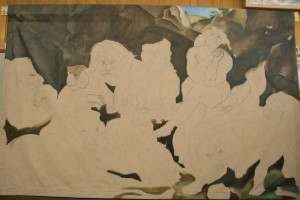 My client begged me to paint Daniel months, no even a year, before I agreed. Frankly, I knew just how many hours I was looking at, and it took me almost that long to get my studio ready, inching the furniture over the whole 30 feet of it to provide a working space for not only a 5’ x 8’ canvas, loose hanging, but for the footprint of the homemade easel he had built, about 5’ out into the room, ca. 5’ x 8’ x 8’. That cuts a swath out of any artist’s studio.
My client begged me to paint Daniel months, no even a year, before I agreed. Frankly, I knew just how many hours I was looking at, and it took me almost that long to get my studio ready, inching the furniture over the whole 30 feet of it to provide a working space for not only a 5’ x 8’ canvas, loose hanging, but for the footprint of the homemade easel he had built, about 5’ out into the room, ca. 5’ x 8’ x 8’. That cuts a swath out of any artist’s studio.
Several attempts had been made to produce a Daniel in his classroom (not in art, but another subject) where he called me in to teach his students how to paint Daniel on burlap. Seams ran through the whole thing; the raw burlap ate up his paint. It was during that time that I groused enough about following the discoveries artists had made over the centuries for building lasting canvas art, like putting gesso on the surface—as glue for succeeding layers and assurance the chemicals in paint would not eat through the cloth and to keep the color from being leeched away—that the client adapted his model and perfected his vision.
I couldn’t talk him out of the loose hanging tapestry look, which I tried to do simply because when oil paint ages, it rigidifies, and we didn’t want it cracking and falling off a loose ground (that’s the surface). But I researched the chemical nature of classical additives through the Portrait Society of America, an awesome society to which I have belonged some years.
 I discovered from one of the top fine art chemical specialists in the U.S. that the newer product for glazing oils maintains its elasticity over time, while linseed oil grows ever more rigid when it dries. That reassured me. I hunkered down to paint the canvas lying flat on a smooth board.
I discovered from one of the top fine art chemical specialists in the U.S. that the newer product for glazing oils maintains its elasticity over time, while linseed oil grows ever more rigid when it dries. That reassured me. I hunkered down to paint the canvas lying flat on a smooth board.
The new canvas was doubled and painted on the back, the top and bottom seamed to hang over a large rod, according to the client’s vision. Obviously, the molding showing was provisional and would be replaced later by a fine one.
Some of the initial work had been drawn in by a student,
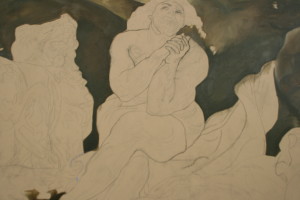 who, though very talented, had not been trained in any way by a skilled artist and had only used a projector to transfer lines. The client and the student shared a common misconception that this process brings accuracy. Peter Pauls’ lines had to be repeatedly studied to bring revelation to lines drawn on by projector following. Take for instance the distortion in the shoulder to the viewer’s right which gives him a very fat and distorted lower arm. This was, in fact, a confusion of the arm with Daniel’s belly, and the subtle changes resulted in a major improvement.
who, though very talented, had not been trained in any way by a skilled artist and had only used a projector to transfer lines. The client and the student shared a common misconception that this process brings accuracy. Peter Pauls’ lines had to be repeatedly studied to bring revelation to lines drawn on by projector following. Take for instance the distortion in the shoulder to the viewer’s right which gives him a very fat and distorted lower arm. This was, in fact, a confusion of the arm with Daniel’s belly, and the subtle changes resulted in a major improvement.
In fact, lines and masses are frequently mis-drawn and mis-interpreted using this system. Without a 3-dimensional working knowledge of figures, many systems for so-called accuracy break down, so I was faced with redrawing radically. Did the drawing beneath help? Of course, almost any drawing helps, but the lines were done in a melted illustration fashion, and the difficult passages like hands, drapes, feet, eyes, obtained a warp that needed re-drawing, a process that continued well into the final phases of the painting.
I was so grateful for my training in Germany years back from a German oil painting master in figure and Old Masters’ painting. Not that no mistakes can be made even then, but major ones are certainly avoided with eye checks of various sorts, and with understanding of actual masses of flesh.
To boot, the drawing actually fell off the final edge in IMG 8383, due to a common distortion of extending the figures seen to fit a knowledge base which ignores a size decrease inherent in foreshortening.
Also, the rock formations were extremely flat and painted an unsympathetic brown, but that I determined to ignore until I made headway with a lion here and there, so I squeezed out paint from my tubes and sat down to begin my work.
I discovered that the seamed double canvas, much to my delight, was easy to work on. Its decided ‘tooth’—it was almost scratchy—caught the paint. You might say it actually grabbed it. I mixed my neutral colors, the colors of your basic metallics which I excel at, and began to use my foolproof system for laying on the paint. You paint on the larger shapes beneath, and you put in a medium range of the shades and colors you are painting.
Without obsessing on detail, an artist can make great progress, exact enough to return to with lighter lights and darker darks at a future sitting. Colors need a base and depth, especially hair, and this system ensures that succeeding stages do not look ‘tacked on’ and caricaturish. This happens when you paint flat colors to begin with and prolongs the buildup unnecessarily.
Even a final color of gold is much enhanced by an underpinning of the famous Old Masters’ green which reverberates well under flesh tones. In a way those are the tones of the painting, including the lions in their golds and burnt siennas, and the the bright red drape. It sits well even under the more iridescent greys of the bones.
Learn more »
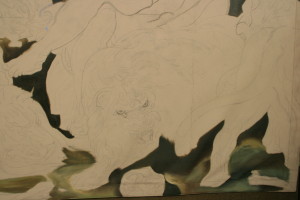
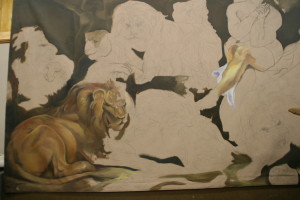
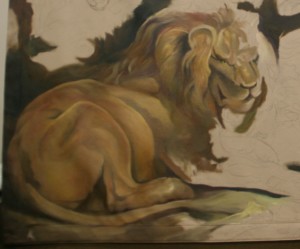
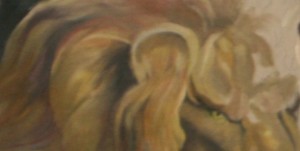
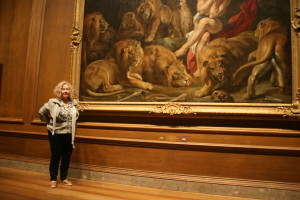
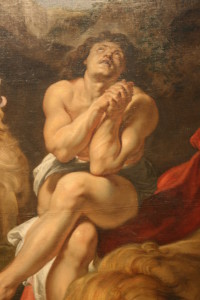 the centerpiece of the Biblical story, at his moment of deliverance, when the King looked in and asked, “Daniel, was your God able to deliver you?” Even in the presence of the snarling lions, it is obvious this was not his moment of greatest fear, but was at a moment when he had a certain amount of peace and knew that the lions’ mouths were indeed shut, as the account goes. Emotion, attitude, and composition joined in this work of Rubens, and I had to study the emotional impact. I took particular note of the lighting and shadowing while I was there.
the centerpiece of the Biblical story, at his moment of deliverance, when the King looked in and asked, “Daniel, was your God able to deliver you?” Even in the presence of the snarling lions, it is obvious this was not his moment of greatest fear, but was at a moment when he had a certain amount of peace and knew that the lions’ mouths were indeed shut, as the account goes. Emotion, attitude, and composition joined in this work of Rubens, and I had to study the emotional impact. I took particular note of the lighting and shadowing while I was there. Certainly in the extreme detail alone I had my work cut out for me. The hardest act an artist makes in the initial phases is to strip away all of the detail in his or her mind and take the figures down to their largest shapes and color. Think about it—you just can’t paint around a freckle or a hair, so it is useless to try setting that type of detail in in the beginning. However, Peter Paul gave his successors a road map in creating his wonderfully complex composition of organic shapes.
Certainly in the extreme detail alone I had my work cut out for me. The hardest act an artist makes in the initial phases is to strip away all of the detail in his or her mind and take the figures down to their largest shapes and color. Think about it—you just can’t paint around a freckle or a hair, so it is useless to try setting that type of detail in in the beginning. However, Peter Paul gave his successors a road map in creating his wonderfully complex composition of organic shapes.